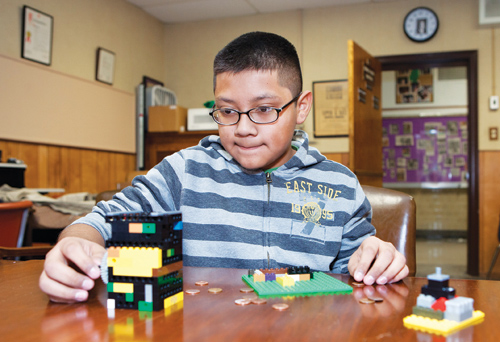Pursuing creative approach to meet new standards

As Greenport sixth-grader Ivan Tapia worked on a picnic table project in his technology class earlier this year, he didn’t know it would inspire him to become a builder.
After he completed his school project, Ivan borrowed his friend’s Legos to construct other things. He then purchased his own set of the building blocks and created a candy machine that offers a Skittle for a penny.
As he demonstrated his machine to a group of teachers, he pushed in a penny and a lever released one of the bright-colored candies.
“Tech class was fun and it got me into building things,” Ivan said. His next independent project is to make a soda machine out of Legos to hold eight cans.
Greenport Elementary School principal Joe Tsaveras said this is the first year that sixth graders are taking technology and home economics classes, which have previously been first offered when students enter seventh grade.
The change is part of the district’s decision to immerse students in the science, technology, engineering and math program, known as STEM, at an earlier age. The goal is to encourage students to become thinkers outside the classroom.
“This is a great example of how one of our students was able to take what he’s learned and create something on his own,” Mr. Tsaveras said of Ivan’s work.
The elementary school has also enhanced its curriculum by adding components of the Common Core State Standards Initiative. The common core standards are a new set of national benchmarks to help public school students master language arts and mathematics. It requires instructors to teach more non-fiction and rigorous math to students at a younger age. The move aims to better prepare students for college and careers.
Mr. Tsaveras said the school recently added Making Meaning and Being a Writer, two new comprehensive reading and writing programs aligned with common core standards.
Teachers are also evaluating new instructional lesson plans, called modules, that the state education department offers as a guide to the common core standards. The lessons are available online at engageny.org.
Second-grade teacher Leslee Cristinao said she’s looking into incorporating the state’s fairy tales module into her classroom because she believes it will be a nice supplement to her existing instruction on the subject.
Fourth-grade teacher Elizabeth Burns said this is the second year students are using a new program called Go Math. Also aligned with common core standards, the program has an interactive component that works with the school’s Smart Boards. She’s also currently integrating the state’s colonial history module into her classroom.
“It involves a lot of deep reading and rigorous vocabulary,” Ms. Burns said. “We’re taking the time to deconstruct it for students.”
To make sure students don’t fall behind as tougher programs are implemented, the district is offering new types of support for teachers and students.
Teachers are creating “individual differentiated instruction” as each student’s learning ability is identified, Mr. Tsaveras said. Teachers receive support for providing one-on-one instruction through the district’s Response To Intervention, or RTI, program, a new state-mandated effort that last year replaced the school’s Reading First program.
In addition to providing more individualized instruction, Mr. Tsaveras said, RTI helps teachers create two student groups. Students in one concentrate on overall classroom instruction. Students in the other get more instruction tailored to their individual needs.
Ms. Cristinao and Ms. Burns said they’ve come up with new ways of challenging their students thanks to the district’s new professional development opportunity, called What I Need, or WIN. To develop in-class solutions to meet each student’s needs, teachers across grade levels meet before and after school, as well as on weekends, to discuss ideas and collaborate on lesson plans. Instructors from each grade level also meet once a month to come up with ways of enhancing teaching techniques.
“Being such a small school, we’re pretty tightknit anyway and we know all of the children,” Ms. Cristinao said. “We don’t suffer in silence. We support each other.”
Mr. Tsaveras said the support structure will help his staff cope with recent changes to the state’s student assessment and teacher evaluation processes. He believes the ongoing collaboration among his teachers will also help them quickly identify a struggling student.
“This is the best staff I have ever worked with,” he said. “They are extremely focused, caring and dedicated.”








